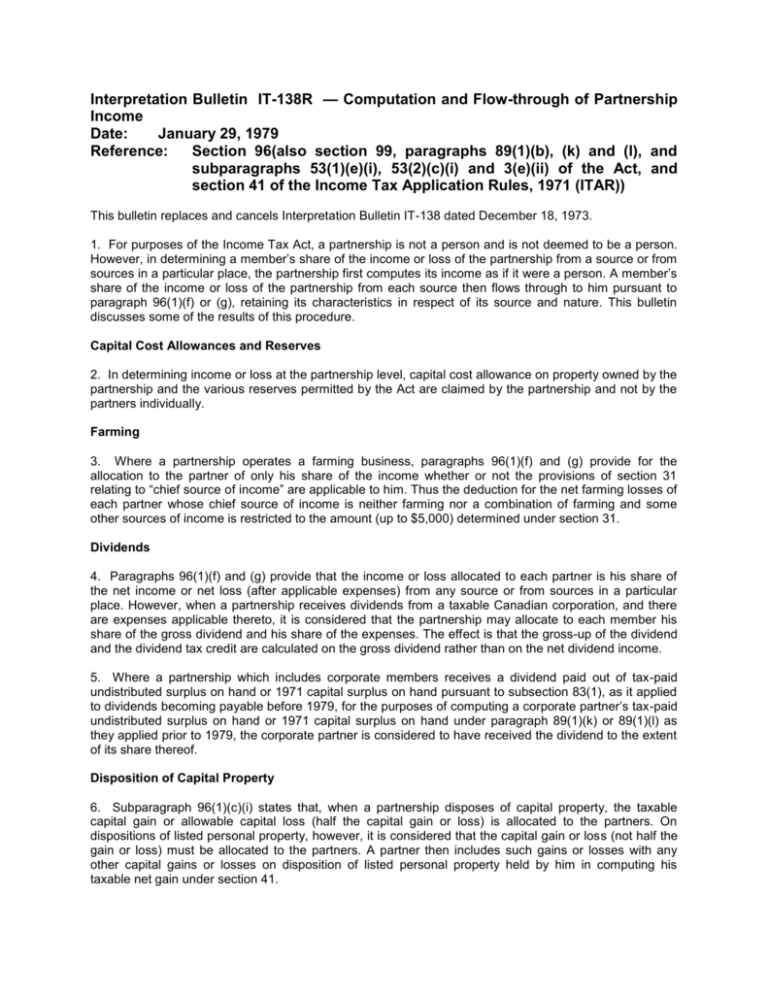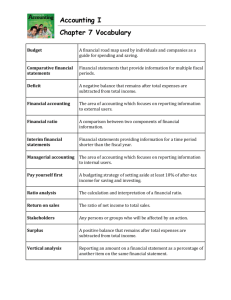Interpretation Bulletin IT-138R — Computation and Flow
advertisement

Interpretation Bulletin IT-138R — Computation and Flow-through of Partnership Income Date: January 29, 1979 Reference: Section 96(also section 99, paragraphs 89(1)(b), (k) and (l), and subparagraphs 53(1)(e)(i), 53(2)(c)(i) and 3(e)(ii) of the Act, and section 41 of the Income Tax Application Rules, 1971 (ITAR)) This bulletin replaces and cancels Interpretation Bulletin IT-138 dated December 18, 1973. 1. For purposes of the Income Tax Act, a partnership is not a person and is not deemed to be a person. However, in determining a member’s share of the income or loss of the partnership from a source or from sources in a particular place, the partnership first computes its income as if it were a person. A member’s share of the income or loss of the partnership from each source then flows through to him pursuant to paragraph 96(1)(f) or (g), retaining its characteristics in respect of its source and nature. This bulletin discusses some of the results of this procedure. Capital Cost Allowances and Reserves 2. In determining income or loss at the partnership level, capital cost allowance on property owned by the partnership and the various reserves permitted by the Act are claimed by the partnership and not by the partners individually. Farming 3. Where a partnership operates a farming business, paragraphs 96(1)(f) and (g) provide for the allocation to the partner of only his share of the income whether or not the provisions of section 31 relating to “chief source of income” are applicable to him. Thus the deduction for the net farming losses of each partner whose chief source of income is neither farming nor a combination of farming and some other sources of income is restricted to the amount (up to $5,000) determined under section 31. Dividends 4. Paragraphs 96(1)(f) and (g) provide that the income or loss allocated to each partner is his share of the net income or net loss (after applicable expenses) from any source or from sources in a particular place. However, when a partnership receives dividends from a taxable Canadian corporation, and there are expenses applicable thereto, it is considered that the partnership may allocate to each member his share of the gross dividend and his share of the expenses. The effect is that the gross-up of the dividend and the dividend tax credit are calculated on the gross dividend rather than on the net dividend income. 5. Where a partnership which includes corporate members receives a dividend paid out of tax-paid undistributed surplus on hand or 1971 capital surplus on hand pursuant to subsection 83(1), as it applied to dividends becoming payable before 1979, for the purposes of computing a corporate partner’s tax-paid undistributed surplus on hand or 1971 capital surplus on hand under paragraph 89(1)(k) or 89(1)(l) as they applied prior to 1979, the corporate partner is considered to have received the dividend to the extent of its share thereof. Disposition of Capital Property 6. Subparagraph 96(1)(c)(i) states that, when a partnership disposes of capital property, the taxable capital gain or allowable capital loss (half the capital gain or loss) is allocated to the partners. On dispositions of listed personal property, however, it is considered that the capital gain or loss (not half the gain or loss) must be allocated to the partners. A partner then includes such gains or losses with any other capital gains or losses on disposition of listed personal property held by him in computing his taxable net gain under section 41. 7. For the purposes of computing the adjusted cost base on dispositions of capital property held by the partnership on December 31, 1971, the median rule under subsection 26(3) of the ITAR, and the provisions of subsection 20(1) of the ITAR in respect of depreciable property apply at the partnership level. Averaging 8. Partnership income from a particular source retains its identity in the hands of a partner. Therefore, to the extent that the income from a particular source qualifies, the partner is entitled to take advantage of the transitional averaging provisions in sections 39, 42, 45, 46 and 48 of the ITAR. Option — End of Fiscal Period 9. The option provided in subsection 99(2) of the Act to move back the date on which a fiscal period ends is available only to an individual. Accordingly, where a partnership (the first partnership) is a member of another partnership (the second partnership) which ceases to exist before the end of its normal fiscal period, the first partnership cannot use that option. For example, suppose that the fiscal period of the first partnership ended on December 31, 1972. The fiscal period of the second partnership ended on June 30, 1972. If the second partnership ceased to exist on October 31, 1972, the first partnership includes in income for the 1972 taxation year its share of the income of the second partnership for the periods ending June 30, 1972 and October 31, 1972. The first partnership cannot use subsection 99(2) to move back the end of the second period from October 31, 1972 to June 30, 1973. Moreover, subsection 41(3) of the ITAR does not apply, in respect of the two fiscal periods of the second partnership, to an individual who is a member of the first partnership. Salaries 10. Salaries paid by a partnership to its members do not constitute a business expense, but are a method of distributing partnership income among members. The income of a partnership in a taxation year may be less than the salaries which the partnership agreement requires to be paid to the partners. In this event, the excess of the salaries over such income appears as a deduction in the partners’ capital accounts. Such a reduction of the capital of each partner is allowed as a deduction in determining the allocation to him of the income or loss of the partnership. 11. For example, suppose that A and B are members of AB partnership. Under the partnership agreement, A is to receive an annual salary of $2,500, after which A and B divide the income or loss equally. The income of the partnership before deduction of the $2,500 salary paid to A is $1,000. The loss after the salary is deducted is $1,500 and $750 is charged to each of the capital accounts. In such a case, A’s income is $1,750 ($2,500 – $750) and B’s loss is $750. Thus A’s income of $1,750 minus B’s loss of $750 equals the income of the partnership. Rent Paid to Partner 12. Where a partnership leases property owned by a partner, the rent is an expense of the partnership and income of the member, and not an allocation of partnership income. Expenses of Partner 13. A partnership agreement may require that certain expenses incurred by a member of the partnership, such as automobile expenses and advertising expenses, are to be paid by each member personally. The member may deduct such expenses to the extent that they are incurred in earning the partnership income. 14. * If the partnership’s fiscal period does not coincide with the calendar year, a partner who is an individual may deduct, in computing his income for a calendar year, those expenses otherwise allowable that were incurred in the calendar year. Alternatively, he may deduct those expenses incurred during the fiscal period to the partnership that ends in the calendar year. 15. The alternative mentioned in paragraph 14 above does not apply to interest expense that is deductible under paragraph 20(1)(c) of the Act on money borrowed by a partner to acquire an interest in a partnership. Adjusted Cost Base of Partnership Interest 16. For the purposes of the additions to and deductions from the adjusted cost base of a partnership interest under subparagraphs 53(1)(e)(i) and 53 (2)(c)(i), the share of income or loss allocated to a partner is computed before any deduction for expenses mentioned in paragraphs 13, 14 and 15 above. Debtor’s Gain on Settlement of Debts 17. Since a partnership has no non-capital losses, net capital losses, or restricted farm losses, its gain on settlement of debts within the meaning of section 80 is applied to reduce as prescribed the capital cost to the partnership of any depreciable property and the adjusted cost base to it of any capital property. Individual Capital Loss Deduction 18. Paragraph 96(1)(c) requires in part a computation of each taxable capital gain, each allowable capital loss and each income and loss of the partnership from each other source as if the partnership were a separate person. The amounts so computed flow-through to each partner by paragraphs 96(1)(f) and (g) to the extent of his share thereof. Therefore, the $2,000 ($1,000 prior to the 1977 taxation year) deduction in respect of allowable capital losses from other income for the taxation year as provided for in subparagraph 3(e)(ii) does not apply at the partnership level but applies to an individual who is a member of the partnership or who is a member of a second partnership who is a member of the partnership. Corporate Partner’s Capital Dividend Account 19. For the purposes of paragraph 89(1)(b) it is considered that each of the items in subparagraphs 89(1)(b)(i), (ii), (iii) and (iv) is to be included in the corporate partner’s capital dividend account to the extent of its share thereof. Limited Partner’s Share of Limited Partnership’s Loss 20. The Department considers that a limited partner’s share of a partnership’s loss pursuant to paragraph 96(1)(g) cannot exceed the lesser of his share of the partnership’s loss as determined by the provisions of the relevant Partnership Act or the agreement between all members of the partnership, and his “equity” in the partnership determined as the aggregate of the capital he has contributed and any amount he has agreed to pay to the partnership as an additional capital contribution plus or minus the net adjustments to the adjusted cost base of his interest in the partnership pursuant to paragraphs 53(1)(e) and 53(2)(c). Any loans or advances made to the partnership by a limited partner and any obligations of the partnership guaranteed by a limited partner are not considered to be an addition to partnership “equity”. General 21. The following is a list of Interpretation Bulletins which discuss the flow-through of other items: IT-73R2 Meaning of Active Business Income IT-81R Partnership-Income of Non-Resident Partners IT-125R Disposition of Resource Properties IT-183 Foreign Tax Credit -- Member of a Partnership IT-245 Income-Averaging Annuity Contracts for Partners and Beneficiaries of Trusts IT-333 Interest and Dividend Deduction IT-346R Commodity Futures and Certain Commodities




